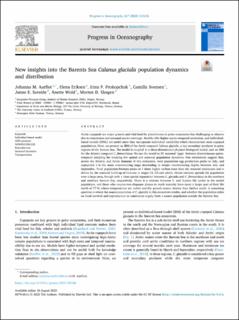| dc.description.abstract | Arctic copepods are major grazers and vital food for planktivores in polar ecosystems but challenging to observe due to remoteness and seasonal sea ice coverage. Models offer higher spatio-temporal resolution, and individual-based models (IBMs) are useful since they incorporate individual variability which characterizes most copepod populations. Here, we present an IBM of the Arctic copepod Calanus glacialis, a key secondary producer in polar regions of the Barents Sea. The model is coupled to a three-dimensional physical-biological model, and an IBM for the Atlantic congener C. finmarchicus. We use the model to fill seasonal “gaps” between discontinuous spatio-temporal sampling for studying the spatial and seasonal population dynamics. Our simulations suggest that, across the Atlantic and Arctic domains of this ecosystem, total population egg production peaks in July, and copepodid 3 is the main overwintering stage descending to deeper overwintering depths between July and September. Total population biomass peaks at 5 times higher carbon mass than the seasonal minimums and is driven by the seasonal build-up of biomass in stages C4, C5 and adults. Ocean currents spreads the population over a large area, though with a clear spatial separation between C. glacialis and C. finmarchicus in the northern and southern Barents Sea, respectively. There is a mixture between 1- and 2-years life cycles in the model population, and those who require two diapause phases to reach maturity have spent a larger part of their life north of 77°N, where temperatures are colder and the growth season shorter than further south. A remaining question is where the source population of C. glacialis in this ecosystem resides, and whether the population relies on local survival and reproduction or continuous supply from a source population outside the Barents Sea. | |
